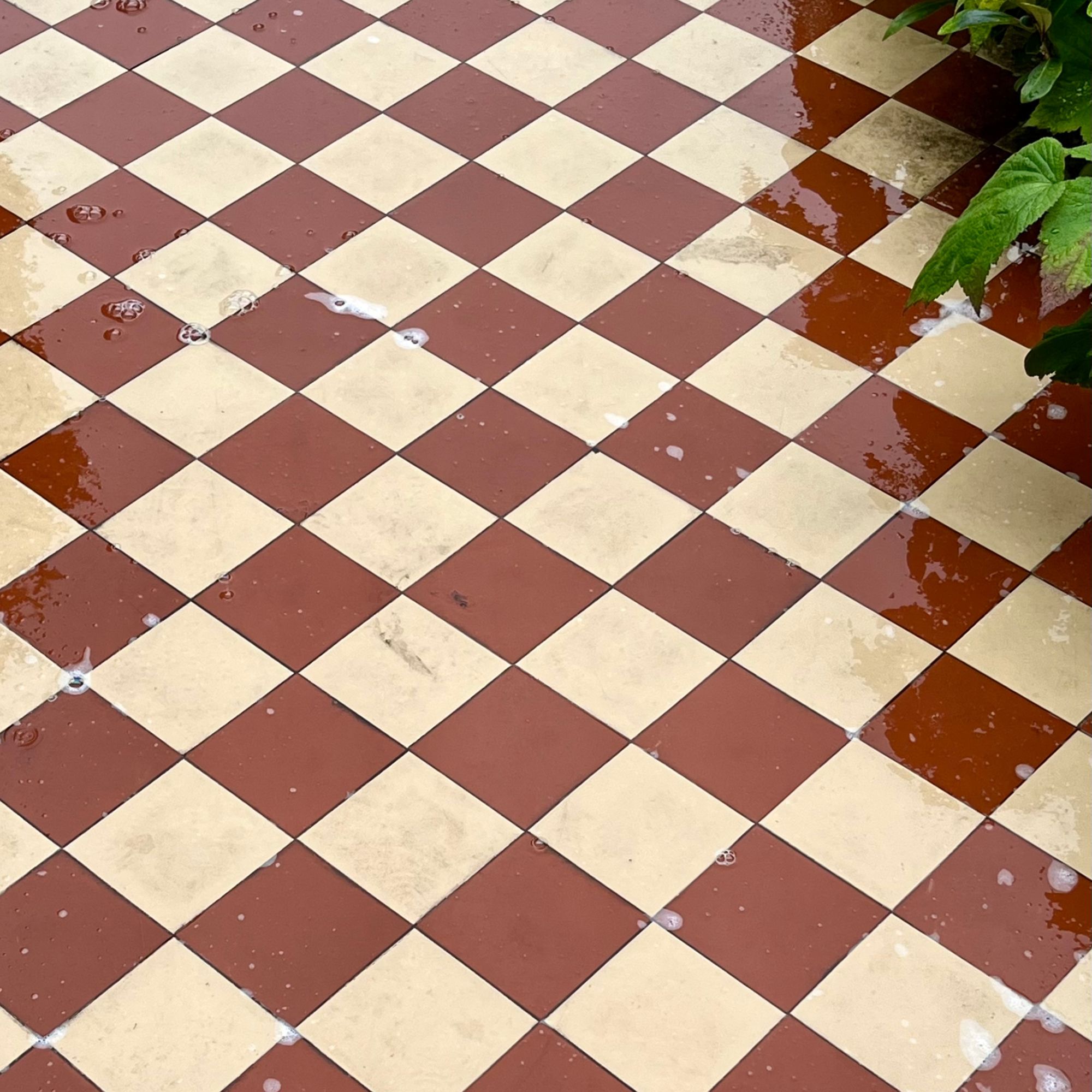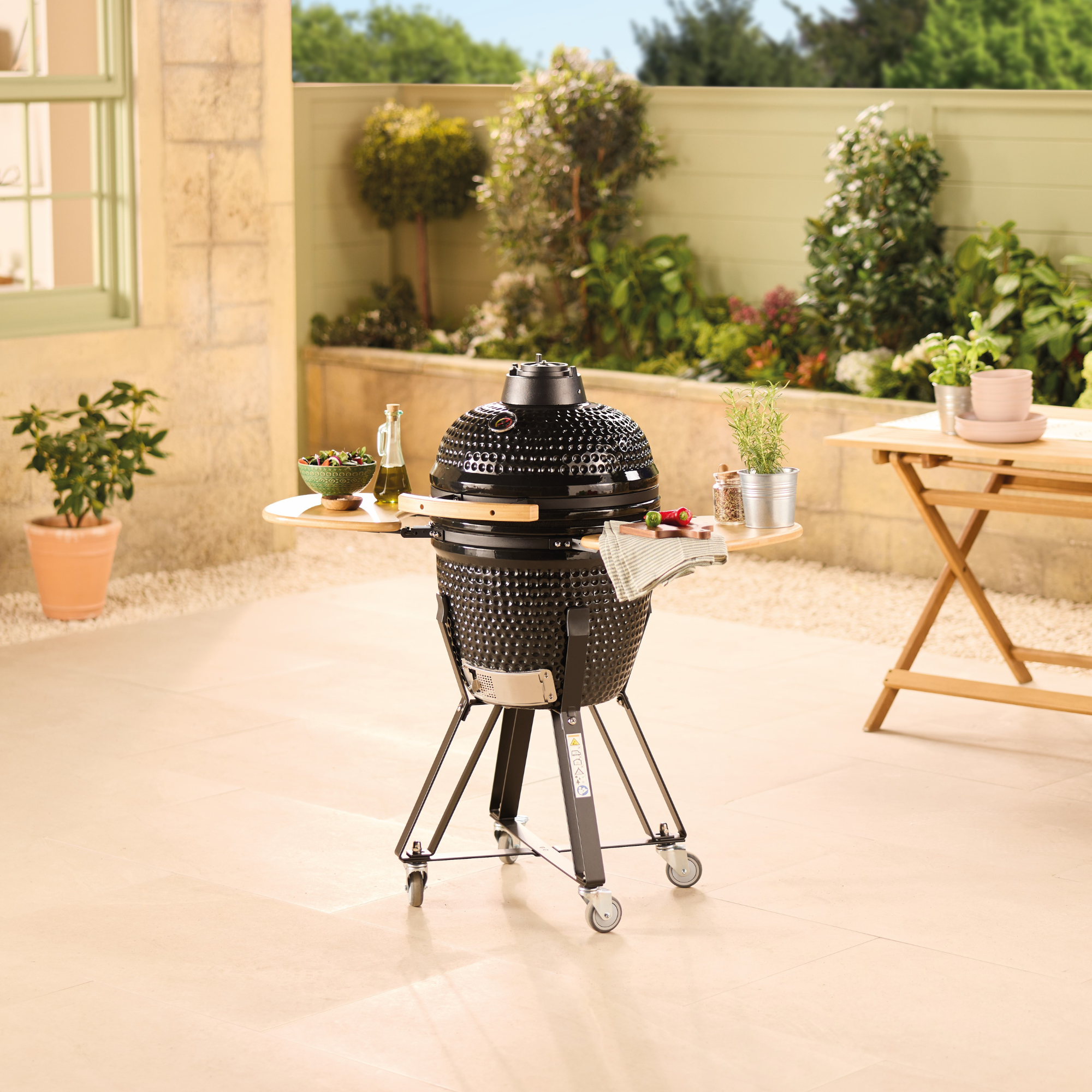I tried Wet & Forget Mould, Lichen and Algae Remover to clean my path and driveway – the results were astounding and I’ll never use a pressure washer again
The rain this summer has proved a bonus – helping to speed up the process of almost effortless cleaning of encaustic tiles with this wonder product


Between autumn and spring every year, the encaustic tiles on my front path – particularly those beneath overhanging plants – grow a sticky, engrained lichen that absolutely refuses to budge, however hard I work at it.
This spring, though, I was sent a 5L carton of Wet & Forget Mould, Lichen & Algae Remover (which you can buy at Amazon) to try at home. It’s on Ideal Home’s list of the best patio cleaners, and I had heard it was good – but I wasn’t convinced it would remove the lichen.
After all, my Kärcher K 4 Power Control Home Pressure Washer (also available at Amazon, if you’re in the market) is rated as one of the best pressure washers, and that hasn’t been able to shift it over the years. I was quickly proved wrong – this product is not only easy to apply, it’s something of a miracle worker where pressure washers fail. The results aren’t instant, though – as I’ll explain.

How does Wet & Forget work?
You simply sweep your path – or almost any outdoor surface, including fences, roofs and even artificial grass – clean of debris, then soak it with a solution of one part Wet & Forget to five parts water to your clean, dry surface. The quickest, easiest way to apply it is with a pressure sprayer – this Spear & Jackson Pressure Sprayer at Amazon has over 24,000 five-star reviews – or, you can do what I did and mop it on.
It leaves a slightly sticky residue that has to be allowed to dry out – so don’t apply it on a day when rain is forecast any time within the next five or six hours, don’t let pets near it and try not to walk on it. I applied mine early on in the evening when I wasn’t planning on going out again.
Then, after a solid 15 minutes of fairly effortless mopping, I waited… for rain, which quickly removed the residue of the product and, over the next few days and weeks, more slowly washed away the invincible sticky lichen – you can see the before picture above and the after picture below.

Since it can take months for the lichen to regrow, I can simply just reapply a second coat in around three months to discourage any further growth. And yes, the weather is what does the trick in helping to remove the lichen, but if it doesn’t rain – I’ve given up on summer, so I’m pretty sure it will – you can mimic the effect with your hosepipe or watering can.
Get the Ideal Home Newsletter
Sign up to our newsletter for style and decor inspiration, house makeovers, project advice and more.
An added bonus? The product does not harm plants unless you spray it directly onto them, which can cause some leaf burn.

Testing Wet & Forget against other products
One of my colleagues tested Wet & Forget alongside two other patio cleaning products in the summer of 2022 – nearly two years ago to the day. She brushed it onto a section next to the other products, clearly separated by masking tape, with Wet & Forget in the middle section.

The results were obvious in a couple of weeks, but in three months, it was even more evident that the Wet & Forget worked better than the competitors. While all three had cleared most of the moss and lichen, the central section where Wet & Forget had been was definitely the cleanest – all without any scrubbing.

And, the product continues to work over time. Now, two years later, the rectangle to the right has all but returned to the colour and lichen coverage of the rest of the paving (you can only just see the outline of the section).
The left-hand rectangle is much better with only some slight marking, but the central rectangle, where Wet & Forget was used, has escaped all but the most persistent dirt.

What the reviews said
Finally, I was curious to see how other users had got on with the product so I dipped into Amazon’s reviews. Some reviewers highly recommended it not just for paths and fences but also for the exterior of their homes which were plagued with moss.
The one that chimed most with me was from a reviewer who said, ‘I’ve done the pressure spray approach before. It’s painfully slow and messy, especially if you do it properly and resand the gaps and seal the blocks.
My pressure hose deals with dirt, but struggled with the lichen. So, in short, this is vastly easier and vastly faster and vastly more effective. Just vastly slower [to see the results]. So it’s a once a year thing – do it once, takes 20 mins and never ever needs thinking about again.’

Sophie joined the Ideal Home team as Gardens Editor in June 2024. After studying English at Royal Holloway, University of London, she began writing for Grow Your Own, which spurred on her love of gardening. She's tried growing almost every vegetable under the sun, and has a soft spot for roses and dinnerplate dahlias.
As Gardens Editor, Sophie's always on the lookout for the latest garden trend. She loves sharing growing hacks for every space, from herbaceous borders to balconies.
-
 Should an air fryer be on display in a kitchen or hidden away? This is why I always keep my small appliances on the worktop
Should an air fryer be on display in a kitchen or hidden away? This is why I always keep my small appliances on the worktopAre you on team display or neatly hidden away? Share your opinion in the comments
By Rebecca Knight
-
 Experts warn that these 5 mopping mistakes are making your floors dirtier — and damaging your floors in the process
Experts warn that these 5 mopping mistakes are making your floors dirtier — and damaging your floors in the processThis is how to keep them clean and avoid costly damage
By Lauren Bradbury
-
 Move over, fences – dead hedges are the wild and wonderful alternative your garden will love and they're easier to build than you'd think
Move over, fences – dead hedges are the wild and wonderful alternative your garden will love and they're easier to build than you'd thinkThe perfect eco-friendly solution for small gardens
By Kayleigh Dray
-
 Aldi’s cult Kamado BBQ is returning to stores and it's £100 cheaper than last time
Aldi’s cult Kamado BBQ is returning to stores and it's £100 cheaper than last timeThis budget BBQ is only a fraction of the price of this celebrity favourite
By Kezia Reynolds
-
 Shoppers can’t get enough of The Range’s lemon tree, but I’ve found an even cheaper bestseller at B&Q - it’s perfect for a Mediterranean look
Shoppers can’t get enough of The Range’s lemon tree, but I’ve found an even cheaper bestseller at B&Q - it’s perfect for a Mediterranean lookWelcome the summer with this glorious fruit tree
By Kezia Reynolds
-
 I'm a stylist with an eye for expensive-looking high street finds – these 6 garden furniture pieces at Dunelm are on my radar
I'm a stylist with an eye for expensive-looking high street finds – these 6 garden furniture pieces at Dunelm are on my radarThese pieces all look more than their price tag
By Laurie Davidson
-
 The 6 outdoor lights from Habitat that I'm choosing between to make my outdoor space look more expensive this summer
The 6 outdoor lights from Habitat that I'm choosing between to make my outdoor space look more expensive this summerI couldn’t believe some of the prices
By Ellis Cochrane
-
 Aldi is launching a £200 day bed with four different features - its sleek design is suited to the whole family
Aldi is launching a £200 day bed with four different features - its sleek design is suited to the whole familyYou don't want to miss out on this Specialbuy
By Kezia Reynolds
-
 I’m seeing pastel garden furniture at all my favourite brands this spring, but QVC’s sorbet collection impressed me the most
I’m seeing pastel garden furniture at all my favourite brands this spring, but QVC’s sorbet collection impressed me the mostFresh pastel shades are a great way to liven up your outdoor space
By Kezia Reynolds
-
 I spent the afternoon looking through Wayfair's garden sale – these are the 6 pieces I'm buying immediately for summer
I spent the afternoon looking through Wayfair's garden sale – these are the 6 pieces I'm buying immediately for summerThese are my must-have garden buys from the sale
By Holly Reaney
-
 I’ve found the perfect alternative to John Lewis’ sold-out striped garden chair – and you won’t believe where it's from
I’ve found the perfect alternative to John Lewis’ sold-out striped garden chair – and you won’t believe where it's fromJohn Lewis' Sling Garden Chair is one of the most stylish pieces of garden furniture I'd seen – until I tracked down this QVC lounge chair...
By Kezia Reynolds